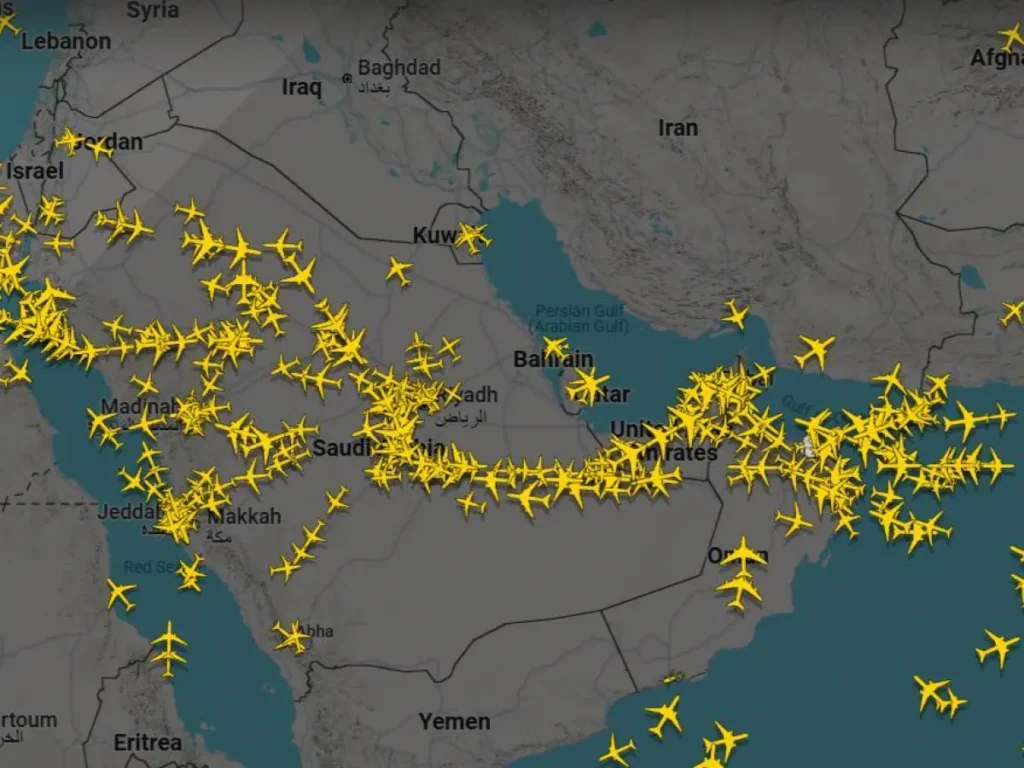The Gulf airspace closure by Kuwait, Bahrain, Qatar, and the United Arab Emirates is sending shockwaves across the region and beyond. With skies shutting down one after another, the world is watching closely as the Gulf, long seen as a hub of energy, trade, and travel, grapples with growing uncertainty.
This sudden move has raised pressing questions: Why are these closures happening now? What impact will they have on airlines, travelers, and economies that depend heavily on Gulf connectivity? And, most importantly, what does this signal about the rising tensions in a region already known for its fragile balance?
In this article, we break down the sequence of closures, the reasons behind them, the implications for local and global stakeholders, and what lies ahead if the situation continues to escalate.
Gulf airspace closure: A chain reaction
The first domino fell when Kuwait announced the suspension of its airspace, citing security concerns. Soon after, Bahrain followed with a similar decision, citing risks to civilian aviation. Then Qatar and the UAE joined in, effectively blocking some of the busiest flight corridors in the world.
For travelers and airlines, this is no small disruption. The Gulf is home to major carriers like Emirates, Qatar Airways, and Etihad Airways, which connect Europe, Asia, Africa, and the Americas through massive hub airports in Dubai, Doha, and Abu Dhabi. Closing these skies does not just affect regional flights; it shakes the global aviation map.
What makes this particularly significant is that the closures are not coordinated under one umbrella decision. Instead, they appear to be a sequence of unilateral moves driven by rising fears of conflict spillover.
Why is the Gulf shutting its skies?
There are several intertwined reasons behind the sudden closures:
- Security threats from ongoing regional conflicts raise fears of missile attacks, drone strikes, or other dangers to civilian aircraft.
- Governments are taking precautionary measures, choosing to ground flights and close airspace rather than risk a catastrophic aviation incident.
- Airspace closures can act as geopolitical signaling, showing seriousness in a crisis without escalating to direct conflict.
- Broader instability across the Middle East is contributing to fears that tensions could spill over into Gulf territory.

Impact on global aviation
The Gulf airspace closure disrupts not only local flights but also long-haul travel between continents.
Flights from Europe to Asia often transit over Gulf skies. Diversions mean longer routes, higher fuel costs, and delays. Gulf airlines, some of the largest in the world, may see massive operational losses. Emirates and Qatar Airways, which rely on their hub-and-spoke model, could face the biggest challenges. Cargo transport, from oil shipments to high-value goods, will also slow down, affecting global supply chains.
Travelers are already feeling the pinch. Passengers report flight cancellations, rerouting through alternative hubs, and skyrocketing ticket prices. For a region that brands itself as a global crossroads, the closures risk damaging its reputation for seamless connectivity.
Economic fallout for the Gulf
The Gulf states are not just rich in oil and gas; they have also positioned themselves as aviation, trade, and tourism hubs. Airspace closures directly challenge this strategy.
Tourism is at risk, with Dubai and Doha relying heavily on millions of annual visitors. Trade could suffer since Gulf ports and airports are critical links in global supply chains. While oil mostly travels by sea, disruptions in air logistics could still affect contracts and investor confidence. Investor sentiment is another concern, as airspace shutdowns send a negative signal to markets and may reduce foreign investment.
The Gulf has worked hard to diversify its economies beyond oil. But closures like this reveal the vulnerabilities that still exist when geopolitical risks rise.
How are airlines responding?
Global carriers such as British Airways, Lufthansa, and Singapore Airlines have already rerouted flights to avoid closed Gulf airspace. While this ensures passenger safety, it comes at a cost. Fuel expenses increase due to longer flight paths, delays mount as aircraft need more time in the air, and crew scheduling becomes more complex.
For Gulf-based airlines, the impact is even greater. Emirates, Qatar Airways, and Etihad Airways depend heavily on connecting traffic through their hubs. If their skies remain closed, they risk losing passengers to competing airlines that can offer smoother routes.
The human angle: stranded passengers and disrupted lives
Behind the headlines are real human stories. Families stuck at airports, business travelers missing meetings, students unable to return to campuses, and migrant workers, who are the backbone of Gulf economies, facing uncertainty about travel home.
Social media is filled with posts from stranded passengers, many of whom are frustrated by poor communication from airlines. Some describe chaotic scenes at airports where information is scarce and rebooking options limited.
The airspace closures highlight how geopolitical decisions, even when made for safety reasons, ripple down to ordinary people in profound ways.
Regional politics: More than aviation at stake
The Gulf airspace closure cannot be viewed in isolation. It is deeply tied to regional politics and security dynamics.
The Gulf has long been a hotspot for power struggles, whether between Iran and Gulf states, or among Gulf nations themselves. Airspace closures may reflect fears of spillover from regional conflicts, maritime tensions, or even cyber threats that could target aviation infrastructure.
In some ways, shutting the skies is a safer form of escalation. It signals alarm but avoids direct confrontation. However, if closures persist, they risk becoming a self-fulfilling prophecy of instability, making conflict seem even more imminent.
International reactions
The global community has reacted with concern. The International Civil Aviation Organization urged Gulf states to coordinate more effectively to avoid unnecessary disruption. The United Nations called for restraint, while the European Union and the United States advised their citizens to reconsider travel plans.
Insurance firms are also adjusting. Higher risks mean increased premiums for airlines flying near the Gulf, further driving up costs.
Possible scenarios ahead
What happens next depends on how long the closures last and whether they expand.
One scenario is temporary closures, where skies may reopen within days if tensions ease, causing limited long-term impact. Another possibility is prolonged shutdowns, where airlines permanently shift routes and Gulf carriers lose market share. The most worrying scenario is wider escalation, where other countries join in or conflict intensifies, creating one of the largest aviation crises since the COVID-19 pandemic.
The Gulf’s challenge: balancing safety and connectivity
For Gulf states, closing airspace is both a necessary precaution and a painful sacrifice. Their prosperity relies heavily on being open and connected, not closed and isolated.
The big question now is whether leaders can find a way to ensure safety while restoring the Gulf’s role as a global aviation hub.
Conclusion
The Gulf airspace closure is more than just an aviation story. It is a reflection of the region’s fragility, a test of its resilience, and a reminder of how interconnected the world has become.
Whether it is a stranded passenger, a business worried about supply chains, or an investor watching oil prices, the Gulf’s skies matter to everyone. As Kuwait, Bahrain, Qatar, and the UAE shut their skies one by one, the world is reminded of a simple truth: in today’s globalized era, what happens in Gulf airspace does not stay in the Gulf, it affects us all.
Read More: Kuwait’s Bold Political Shift: A Moment of Reckoning or Renewal?



